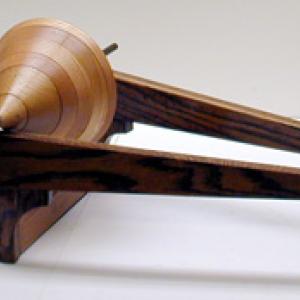College of Liberal Arts & Sciences
1J20.70 - Rolling Uphill
Move the cone to the end of the track and let it go, it will appear to roll uphill. However, if you observe the axle of the cone you will see that it is actually traveling downward.
- Nuri Balta, "New Versions of the Rolling Double Cone", TPT, Vol. 40, #3, Mar 2002, p. 156.
- Paul Hewitt, "Figuring Physics", TPT, Vol. 38, #8, Nov. 2000, p. 482.
- Martin Gardner, "The Ball that Rolls Uphill", TPT, Vol. 34, #6, Sept. 1996, p. 461.
- Paul Chagnon, "Animated Displays III: Mechanical Puzzles", TPT, Vol. 31, #1, Jan. 1993, p. 32.
- R. D. Edge, "String and Sticky Tape Experiments, An 'Antigravity" Experiment', TPT, Vol. 16, #1, Jan. 1978, p. 46.
- Sohang C. Gandhi and Costas J. Efthimiou, "The Ascending Double Cone: A Closer Look at a Familiar Demonstration", European Journal of Physics, June 2005, p. 681.
- "M-482: Double Cone - High Wire Toy", DICK and RAE Physics Demo Notebook.
- Freier and Anderson, "Mr-1", A Demonstration Handbook for Physics.
- Tik Liem, "Rolling Uphill", Investigation to Science Inquiry, p. 317.
- Martin C. Sagendorf, "Why 'Uphill'?", Physics Demonstration Apparatus, 2009. p. 93.
- Jodi and Roy McCullough, "Energy with Gravitation", The Role of Toys in Teaching Physics, p. 4.86.
- Martin Gardner, "91, The Ball That Rolls Up Hill", Smart Science Tricks, p. 134.
- Martin Gardner, "Anti-Gravity Cone", Entertaining Science Experiments with Everyday Objects, p. 87.
- Christopher P. Jargodzki and Franklin Potter, "230, Antigravity", Mad About Physics, p. 91, 227.
- Janice VanCleave, "Up Hill", 200 Gooey, Slippery, Slimy, Weird, Funny Experiments, p. 94.
- Bobby Mercer, "Rolling Uphill", Junk Drawer Physics, IBSN 978-1-61374-920-3, p. 14 - 16.
- Joseph Frick, "# 63 - The Cone Which Runs Up Hill", Physical Technics: Or, Practical Instructions for Making Experiments in Physics and the Construction of Physical Apparatus with the Most Limited Means, p. 74.
Disclaimer: These demonstrations are provided only for illustrative use by persons affiliated with The University of Iowa and only under the direction of a trained instructor or physicist. The University of Iowa is not responsible for demonstrations performed by those using their own equipment or who choose to use this reference material for their own purpose. The demonstrations included here are within the public domain and can be found in materials contained in libraries, bookstores, and through electronic sources. Performing all or any portion of any of these demonstrations, with or without revisions not depicted here entails inherent risks. These risks include, without limitation, bodily injury (and possibly death), including risks to health that may be temporary or permanent and that may exacerbate a pre-existing medical condition; and property loss or damage. Anyone performing any part of these demonstrations, even with revisions, knowingly and voluntarily assumes all risks associated with them.
